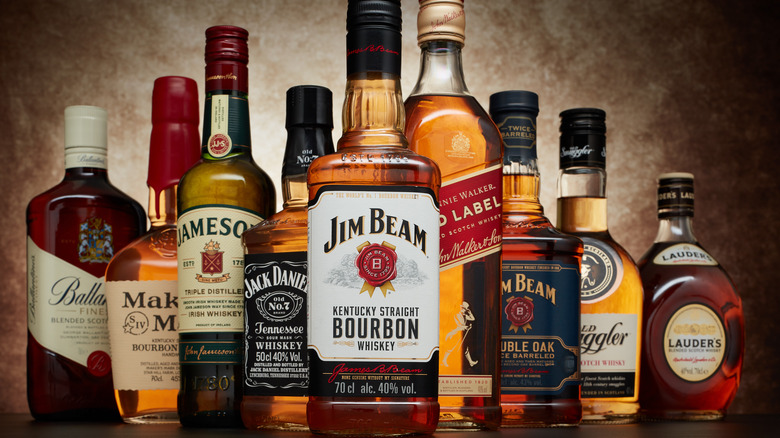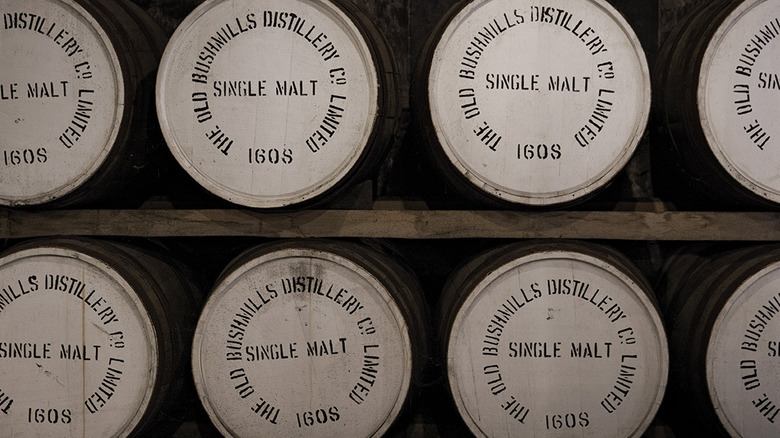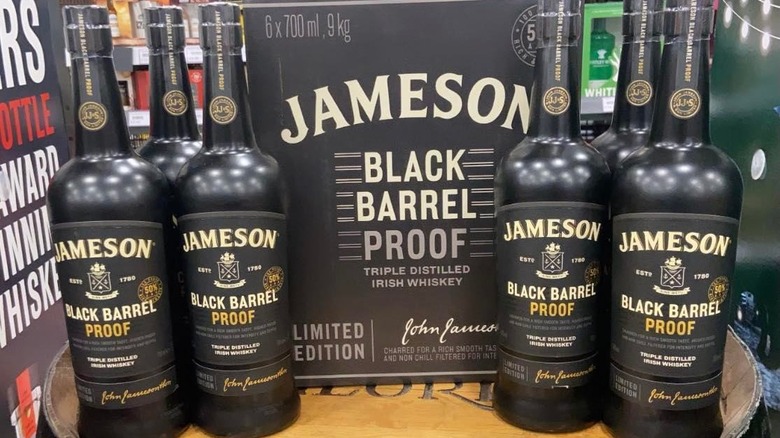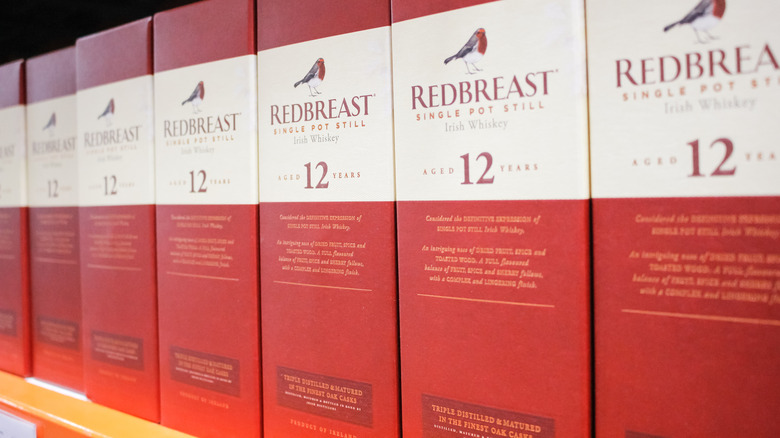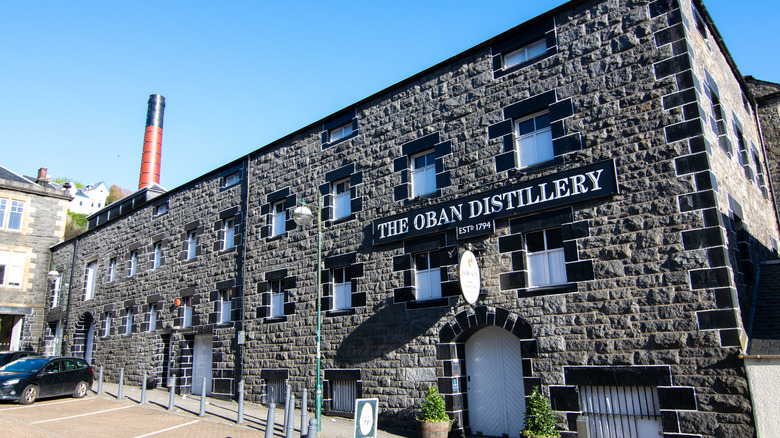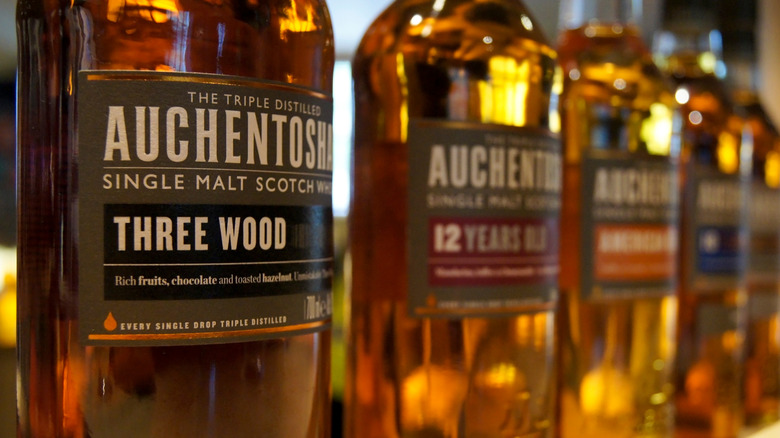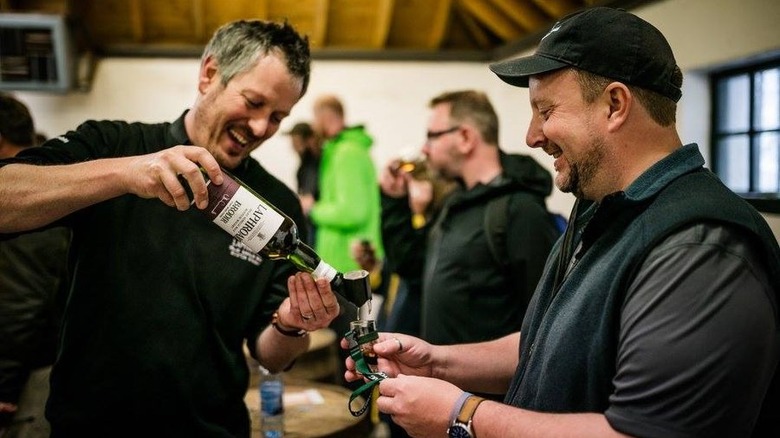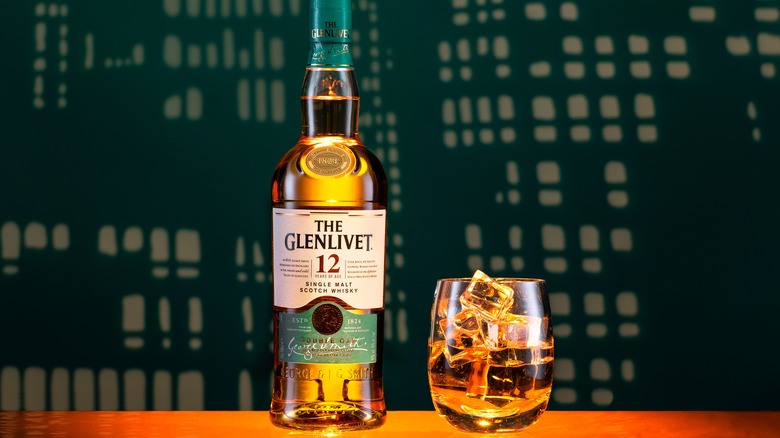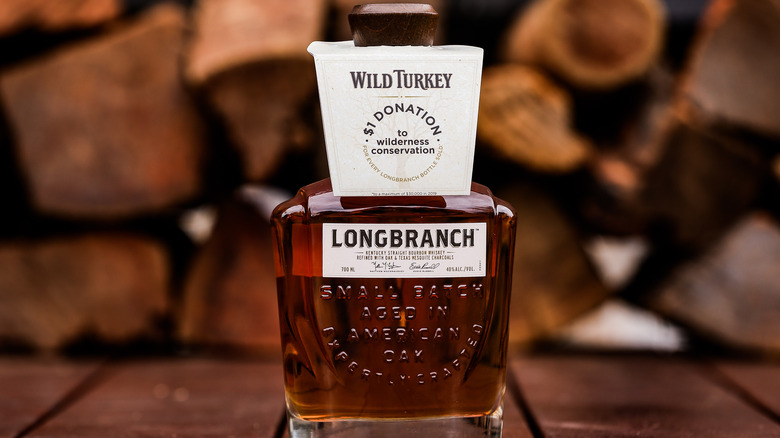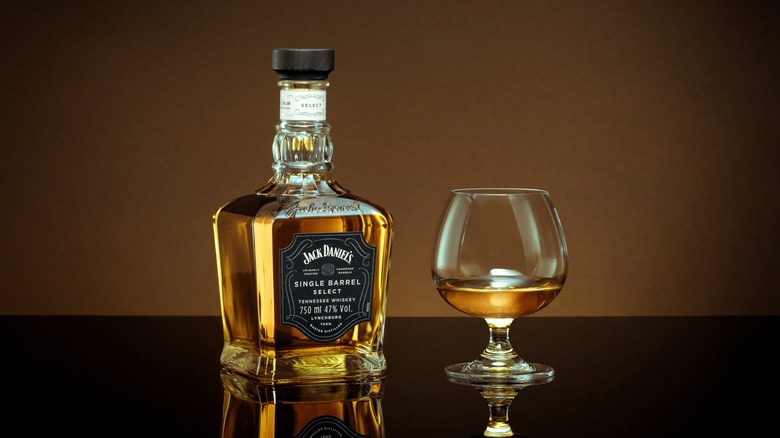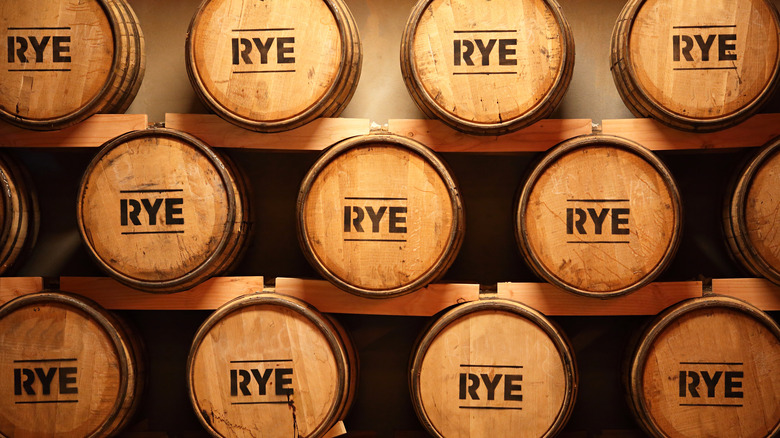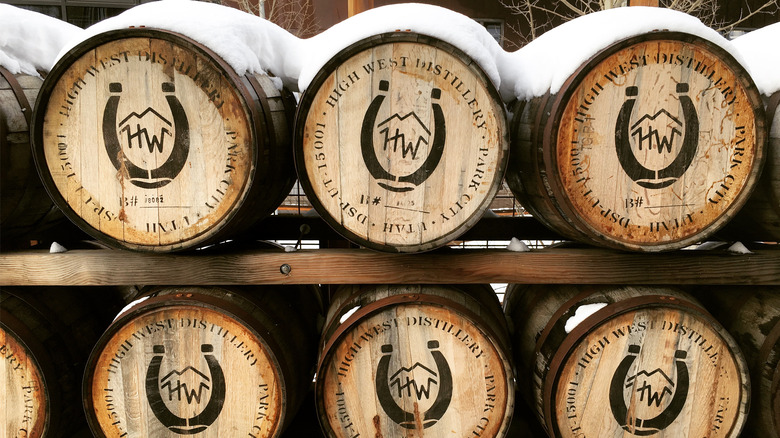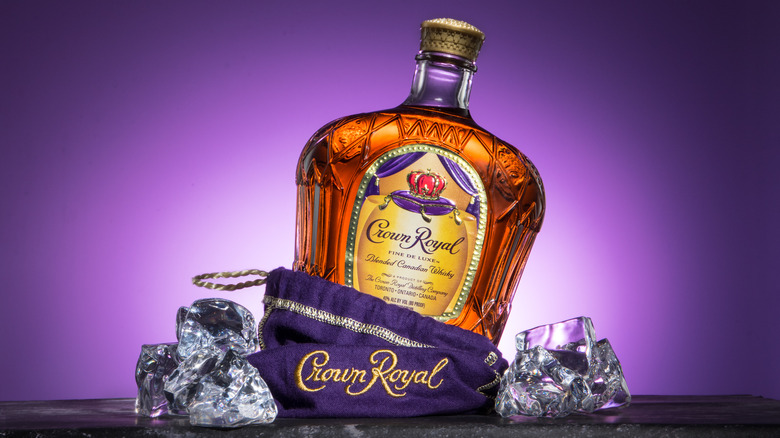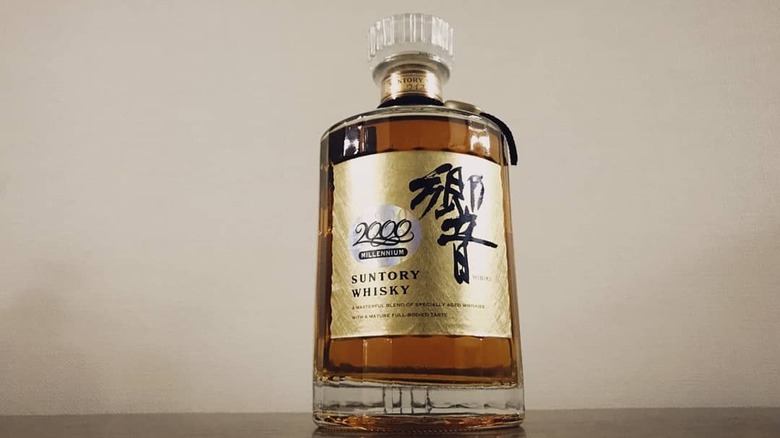13 Types Of Whiskey And What Makes Them Unique
George Thorogood once famously lamented that he wanted one bourbon, one scotch, and one beer. And though we all know George was no stranger to the intricacies of good booze (he drank alone, as you may recall) not all of us know the difference between bourbon and Scotch. Or why an Irish Whiskey might taste different than Tennessee whiskey. Or why Scotland and Japan spell "whisky" without an e.
Dictionary.com defines whiskey as "an alcoholic liquor distilled from a fermented mash of grain ... containing 43 to 50 percent alcohol." And that casts a pretty broad net. But to drill it down to what makes a bourbon a bourbon, and what makes Highland Scotch different from Speyside, it takes a little expertise. Especially because those differentiations involve a lot more than the obvious facts, like that Japanese whisky comes from Japan. Here's a look at 13 different styles of whiskey, and what makes them special.
Irish Single Malt
As the name might imply, Irish single malt whiskey comes from the emerald isle of Ireland. And the name also might imply, it must come from a single malt, rather than a blend of malts (via Vinepair). That is to say, when barley is malted in the whiskey production process, different malts are sometimes put together in the same barrel to create complex or contrasting flavors. In the case of Irish single malt — indeed, all single malts — only one may be used. In addition to these guidelines, Irish single malt must also be aged in oak for at least three years before being bottled, and all of this must happen at the same distillery (via Master of Malt).
As far as tasting notes, these can vary widely depending on the distillery, and how long it's aged the whiskey. Bushmills is probably the best known Irish single malt on the market, and it is, according to Vinepair, the oldest licensed whiskey distillery in the world. It often ages its whiskeys in sherry and port casks, giving fruity aromas and flavors to many of its creations.
Irish Single Grain
With single grain whiskey, the word "single" means something a little different than it does with single malt. Somewhat confusingly, single grain whiskeys can use one grain or a variety of grains, depending on the recipe (via Distiller). But it must all come from one single distillery, and in the case of Irish single grain (and Scotch too) it must be aged for a minimum of three years. It's also frequently triple distilled.
Single grains are more of an ingredient than a standalone product, often blended with single malts and other whiskeys to create signature blends. You won't find a ton of them out there for purchase, though Jameson's Black Barrel Proof is one example, as is Hyde's Cask Strength 8 Year. Irish single grains are easy drinking, according to Distiller, and tend to skew on the sweeter side. They're aged in used barrels as well, and eschew the smoky notes that whiskeys aged in charred barrels can have.
Irish Single Pot Still
Sometimes, cutting corners to save a few bucks isn't a bad thing. Such was the case with Irish distillers of the 19th century, who were paying exorbitant taxes on the malt they used to make their whiskeys (via The Alcohol Professor). Looking for a way to cut costs, they began throwing unmalted barley into their creations. And lo and behold, rather than a cheaper, watered-down product, they created a whiskey that some now prefer: Irish Single Pot Still.
This is Ireland's most unique whiskey, a form of single malt that can only be produced in that country. The main differentiator between Irish single pot still whiskey and regular Irish single malt is that it is made from unmalted, or "green" barley, which gives it a grittier, grainier, almost earthy flavor, according to The Alcohol Professor. The special-to-Ireland style is also made in a pot still — a copper still with a craned neck, as opposed to a column still, the type used for clearer spirits like tequila and rum. It's not abundantly common, especially in the U.S. market, but some brands to look out for are Redbreast 12 Year Old Cask Strength and Green Spot.
Highland Scotch
If you're good at stuff like deduction, you may have figured out that Scotch whisky is from Scotland. But within that country you'll find a number of distinct styles depending on the region where it was distilled. The largest, and most varied, is Highland Scotch, which encompasses the northern part of Scotland ranging from the mountains to the furthest islands (via The Whiskey Wash). This region became Hollywood-famous as the setting for films like "Braveheart" and James Bond's "Skyfall," but it's fairly unpopulated today.
Most whiskies from this diverse region are single malts, meaning they came from a single distillery, made from all malted barley. The region is vast, and because terrain varies throughout the highlands, it's hard to drill down one specific flavor profile. That said, AskMen notes that Highland Scotch often has a peaty tone with a floral and silky smooth mouth feel, though citrus and smoke are also prevalent in many varieties. Common Highland Scotches you may find are Oban, Glenmorangie, and Talisker.
Lowland Scotch
Not quite the opposite of Highland Scotch, Lowland Scotch comes from the southern part of Scotland, a flatter, more agriculturally oriented region of the country (via the Whiskey Wash). These Scotches are milder than their northern brethren, the vast farmlands producing a whisky that's neither peaty nor hefty. The abundance of corn and wheat in the region allows Lowland Scotches to use grains other than malted barley, mostly corn and wheat. Lowland whiskys are also typically triple-distilled in column stills, giving them a mild, smooth profile that's earned them the nickname "Lowland Ladies" (via AskMen).
This smoothness makes Lowland Scotches well suited to those new to whisky, and also makes them popular in blends. Honeysuckle, cream, ginger, and toffee are the most commonly-cited tasting notes, mentioned by Whiskey Wash, Ask Men, and the Scotch Whisky Association. You won't find a ton of Lowland whiskys on the shelf, but if you can get your hands on some Glankinche or Ailsa Bay, give it a try.
Islay
Scotland boasts over 790 different islands, according to the Scotland Info Guide, and to stand out as THE Scottish island with its own style of whisky, you've gotta be doing something right. Or, at least, something different. Such is the case with Islay, an island of just over 3,000 people, according to Islay Info, where nearly everyone is in the whisky business (via The Scotch Whisky Association). Islay Scotches are known for their peat — the earthy, mouth-puckering flavor that some might compare to the metallic marking pens you used to shake up before using. Some love it, some hate it. But Islay does it best.
Legend has it Islay is where the first Scotch whiskys were made, though that's never been confirmed (via AskMen), and its creations are unlike anything else in the country. You'll find strong notes of smoke, pepper, and earth in nearly every Islay Scotch, though some hit a lot harder than others. They're nearly all complex, and few could be described as "easy drinking." But if you're in for an adventure, try Laphoraig, Ardberg, or Lagavulin, all of which are relatively easy to find in America.
Speyside
Probably the most commonly-found Scotch whiskys are Speyside, originating from a northeastern coastal section of the country. It's the most densely populated whisky region in Scotland, and as such boasts over half the nation's distilleries and biggest brands (via AskMen). Names like Glenfiddich, Glenlivet, and Cardhu — Johnnie Walker's first distillery — all come from Speyside. So if you've tried Scotch, odds are you've tried one of these.
Highland flavor profiles can be broken down into two varieties: sweet and grassy. These notes are a result of the casks used to age the whiskys. For a fruitier flavor, distillers use oak casks. For the earthier, lighter flavor sherry casks are the move. Speysides are a little peatier than Lowland whiskys, but not quite as strong as those from Islay. The happy middle ground flavor is also long on fruit, vanilla, pear, and honey (via The Scotch Whisky Association) and makes a nice step up from Lowlands if you're seeking more sophistication.
Bourbon
In America, bourbon and whiskey are often used interchangeably when describing a grain spirit, typically originating somewhere in the South (via Food & Wine). And while that's somewhat correct, it's not entirely accurate. Bourbon is a very specific type of whiskey, so referring to your Wild Turkey as "whiskey" is all good. But throwing any old brown spirit into a glass and calling it bourbon isn't always going to hold up.
First thing's first: For a whiskey to call itself bourbon, it has to be made with 51% or more corn. It can use other grains too, but to achieve the desired sweetness it has to be over half corn. Then, the spirit needs to be aged in never-used charred oak barrels for at least two years. This is why you often see American bourbon barrels when you tour distilleries in Scotland — each barrel can only be used once, so they've gotta go somewhere, and they're often sent on to second lives aging liquors like Scotch, rum, and tequila (via Daily Beast). Further, the original mash has to be distilled to 160 proof, then aged until it's 125 proof or less (via Food & Wine). Finally, bourbon must be diluted to 80 proof, or about 40% ABV. Bourbon usually swings to the sweet side, with strong influences from oak, caramel, and vanilla.
Tennessee Whiskey
Tennessee Whiskey may be the only booze in the world better known as a song than a spirit, a slow-dancing wedding favorite originally recorded by David Allen Coe (via Taste of Country). But the beverage is just as calming, a special style of bourbon that can only be produced in Tennessee. While neighboring Kentucky is famous for its bourbon, technically the stuff could be distilled on Mars and still be called bourbon (unless it's called "Kentucky bourbon," in which case it does actually have to come from there, per Food & Wine). Tennessee whiskey, however, must be made inside the Volunteer State.
And since mass-produced corn doesn't necessarily reflect the same terroir as, say, grapes from Champagne, that might lead one to wonder how Tennessee whiskey is special other than arbitrarily drawn geographical boundaries. That would be the Lincoln County process, a process by which every whiskey must be charcoal filtered before it's bottled (via Liquor.com). This gives it a slightly different flavor than other bourbons, and accounts for the distinct notes you'll find in names like George Dickel's and, of course, Jack Daniel's. Like all bourbons, Tennessee whiskey is overwhelmingly sweet with vanilla, caramel, and oak overtones. But you may also notice a bit more smoothness in this variety, thanks to its extra charcoal filtering.
Rye
Perhaps "American Pie" wouldn't be, seemingly, the longest song in rock and roll history if Don McLean had known something about redundancy. Because if the good ole boys were drinking whiskey and rye, the rye drinkers were technically drinking whiskey as well. Maybe he was getting paid by the word, who knows.
Lyrical confusion aside, rye is, in fact, a form of American whiskey, made from 51% or more rye grain (via Tasting Table). Rye follows most of the same production rules as bourbon does, too, requiring an initial proof of no more than 160 that's diluted down to 125 proof or less. It is also aged in brand new charred oak barrels. But rye differs in that it must be aged at least two years, and it cannot be mixed with any other spirit to be called rye.
But just because rye whiskey uses a similar grain to the bread you use for a pastrami sandwich, don't expect the flavor to be even remotely similar. Rye whiskey is a lot sharper than bourbon, credited to the different grain. Beyond that, flavors really depend on which one you're drinking. George Dickel, Bulleit, and Wild Turkey are some of the brands you may commonly see.
American Single Malt
American Single Malt is sort of the wild west of American spirits, as the relatively new genre doesn't really have anything regulating what it has to be. In its essence, American Single Malt is a U.S. take on the Scotch and Irish original, a malted barley whiskey aged in sherry or bourbon casks and aged for different amounts of time (via Wine & Whiskey Globe). But because whiskeys age differently in America depending on where they're located — a whiskey in Arizona will age very differently than one in Seattle — there's no ageing minimum, nor even a claim to a whiskey's age.
According to ScotchWhisky.com, the relatively-new American Single Malt Commission has proposed some guidelines for the young category, suggesting a 100% malted barley mash, distilled at no more than 160 proof and bottled at no more than 125 proof. Though any regulations have yet to be adopted, flavors generally mirror Scotch and Irish whiskeys to a point, the malted barley giving many a smoky, toasted flavor. If you're up for trying some, Stranahan's from Colorado and Balcones in Texas are known for their single malts (via Virginia Distillery Co.).
Canadian
Our neighbors north of the border are a little more relaxed than we are here in America. At least they are when it comes to the world of whiskey. Where American whiskey styles like bourbon and rye have strict regulations as to the types of grains, barrels, and filtering used in the production process, in Canada the only rule is pretty much "it has to come from Canada."
Ok, that's not completely true. According to Whiskey Advocate, a Canadian whisky must be made up of cereal grain products (wheat, rye, corn, rice, oats, barley, and sorghum), be aged in wood barrels of under 700 liters for a minimum of three years, and "possess the aroma, taste, and character generally attributed to Canadian whisky." Pretty vague, yes, especially since Canadian whiskies are also allowed to use caramel coloring and up to 9.09% flavoring. Most are wheat-based, since the country has an abundance of that particular grain. Because the rules are all over the place, so are flavors. But Canadian Club and Crown Royal are the two brands you'll probably encounter most.
Japanese
Japanese Whisky might be the hottest new kid on the brown spirit block, with one study reporting the global market for it has been growing steadily, and is projected to keep growing. If you've tried it you probably know why, as the Japanese took a cue from the Scotch and have crafted their take on the spirit in much the same way. Many distilleries import their ingredients from Scotland (via Sip Awards), and nearly all of the country's dozen or so distilleries make a single malt (via TimeOut).
Interestingly, demand for the stuff grew so much that Japanese distilleries weren't able to keep up, and they began using imported base spirits in their blends to increase production. As a result, in 2021 Japan finally passed guidelines for what can constitute a Japanese whisky. By 2024, all Japanese whiskys must be fermented, aged, and distilled inside Japan. They must contain some malted grain, use water sourced in Japan, be aged a minimum of three years, and be bottled in the country (via TimeOut). Though it will be a couple of years before you can guarantee authenticity, you'd still be well served to try Suntory or Nikka if you see it in a bar. Japanese whisky generally tastes like Scotch, with less peat and more of a nutty flavor.
